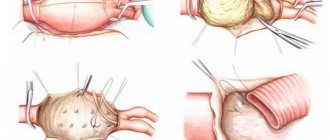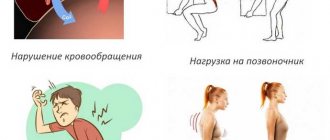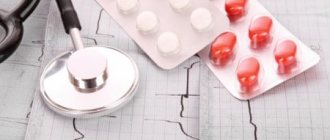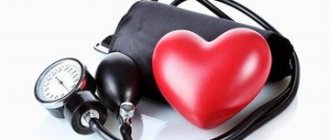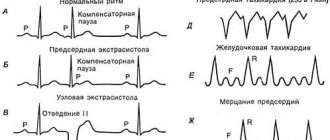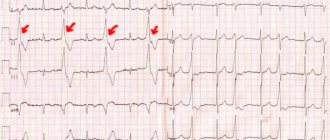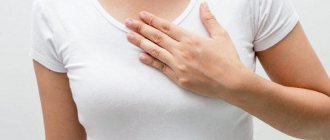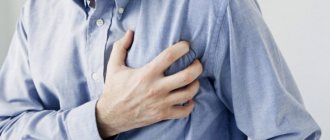I am glad to welcome you, dear readers!
Did you know that such an insidious disease as osteochondrosis can cause heart disease? Today I will tell you whether tachycardia occurs with osteochondrosis and what to do if you notice such a symptom.
Tachycardia is the heart beating too quickly. This condition is familiar to everyone, and if it appears rarely and goes away quickly, there is no threat to health. But in some cases, tachycardia can lead to fainting and even death of the patient.
What it is
The pulse of an adult during the daytime should be in the range from 60 to 90-100 beats per minute. Most often this figure is 65-70 beats. For older people and athletes, the norm can be reduced to 50 beats or even lower.
A pulse exceeding 100 beats per minute is called tachycardia - rapid heartbeat. On the other hand, rare heart beats with a frequency of up to 50-30 times per minute are called bradycardia. The heart contracts under the influence of electrical impulses.
Depending on where the generator of these impulses is located, tachycardia occurs:
- Sinus. It occurs when the activity of the sinus node, the main source of normal heart rhythm, increases.
- Ectopic (paroxysmal). The rhythm generator is located outside the sinus node - in the atria (supraventricular tachycardia) or ventricles (ventricular tachycardia).
Treatment procedure
Arrhythmia in osteochondrosis of the thoracic spine can be eliminated with the help of specialized medications that restore heart rhythm. However, treatment of the initial problem should include the following tasks:
- Elimination of inflammatory processes in the affected area;
- Elimination of direct compression of nerves;
- Improving metabolism in the tissues of the spine and intervertebral discs;
- Restoring the functions of neurons in the affected area.
Therapy is carried out in several stages using different types of influence.
Drug treatment
In addition to drugs that restore normal heart rhythm, other medications are also used to eliminate the painful focus:
- Non-steroidal anti-inflammatory drugs (Diclofenac, Indomethacin, Movalis, Ofen, Ketanov, Naklofen). They are used in the form of tablets, ointments and gels, as well as injections. They also have analgesic properties.
- Antispasmodics (No-Shpa, Drotaverine, Miolastan). Relieves spasms of blood vessels and muscles, eliminates pain.
- Chondroprotectors (glucosamine sulfate, Rumalon, chondroitin sulfate). Promote the restoration of cartilage and bone tissue, prevent destructive processes.
- Medicines that stimulate blood circulation (Trental, Actovegin, nicotinic acid).
- The patient is also prescribed vitamin complexes and antioxidants.
How to determine
You can calculate your pulse using an electronic tonometer - a device for measuring blood pressure. Many of these devices have a built-in function for determining heart rate - heart rate. There is an easier way to count your pulse.
On the inside of the wrist of your left hand in the area of the radial artery, place 3 fingers of your right hand - index, middle and ring. Press the vessel with your fingers, feeling the pulsation of the blood, and note the time on the clock with the second hand.
Usually the pulse is counted for 1 minute, but you can limit it to 30 seconds by multiplying the result by 2. Pay attention to the rhythm of the pulse, the presence or absence of so-called skips - they can also indicate problems in the heart.
How to identify the relationship between diseases
You can detect tachycardia yourself. To do this, take a stopwatch, sit down and relax as much as possible. Now you should squeeze the largest blood vessel (artery), located on the inner surface of the left wrist, note the time and start counting the blows. If their number exceeds 80 in 60 seconds, then this indicates a heart rhythm disorder.
Heart rate measurement.
But it will not be possible to establish a connection between the development of tachycardia and osteochondrosis of any localization at home. Indirect confirmation is its appearance during the period of relapses of degenerative-dystrophic pathology. In such cases, rapid heartbeat is accompanied by acute pain in the neck or back, limitation of movements and other specific signs of osteochondrosis.
Why does it occur
In most cases, increased heart rate is physiological, that is, it occurs in response to stress or excessive physical activity. This condition is considered a normal reaction of the body and quickly passes when the provoking factor is eliminated. Also, the heartbeat increases when the air temperature rises, after drinking alcohol, coffee or strong tea, due to taking certain medications.
If tachycardia occurs for no apparent reason, it is a serious disease provoked by the following conditions:
- congenital anomaly of the cardiac conduction system;
- acquired diseases - atherosclerosis, coronary heart disease, arterial hypertension, endocrine pathologies (increased thyroid function, adrenal tumor).
But can osteochondrosis cause such a phenomenon as tachycardia? The answer is yes, there is a connection between these diseases. Most often, pathology in the cervical spine leads to an increased rhythm. With osteochondrosis, the vessels of the neck that supply the human brain can be compressed.
A smaller amount of blood passes through the narrowed vessels, therefore, in order to avoid oxygen starvation of the brain, the heart begins to work in an increased mode, throwing out as much blood as possible.
If you suffer from a severe form of lumbar osteochondrosis, there may be compression of the internal organs, which affects the adrenal glands. Dysfunction of these glands can also provoke tachycardia.
General recommendations for the treatment of osteochondrosis and the prevention of tachycardia
In order to speed up the process of treating osteochondrosis and cardiac arrhythmia, you must use the following recommendations:
- To refuse from bad habits;
- Diversify your daily diet with fresh vegetables and fruits, eat more products containing gelatin;
- Allow more time for rest and sleep;
- Systematically monitor your heart rate;
- Avoid stressful situations.
In addition, you should not:
Expose the body to high temperatures (visit baths and saunas, make hot compresses, take a hot shower). An increase in temperature can increase inflammation, speed up the heartbeat, increase blood pressure, cause swelling and increase compression of capillaries and nerve roots. Carry out massages yourself
Mechanical impact on the affected spine without the participation of a specialist can aggravate the situation. Take medications that affect the condition of tissues and the cardiovascular system without consulting a doctor. In addition, it is important to monitor your posture and avoid spending long periods in front of the computer. It is also recommended not to use a pillow and choose a firmer mattress.
Visit baths and saunas Perform massages Take medications Monitor your posture
Associated symptoms
How does tachycardia caused by osteochondrosis manifest itself, and what does the patient feel? A person feels his heart pounding, his palms may sweat and his extremities may become cold, hot flashes occur, and his head begins to feel dizzy.
Along with tachycardia, blood pressure often increases, because the heart has to push out a lot of blood. But since too fast contractions of the heart are defective, the pressure may decrease.
If problems with the spine lead to a pinched nerve, pain syndrome develops. The nature of the sensations depends on the location of the lesion - for example, with thoracic osteochondrosis, it often seems that the heart hurts, and when the pathology is localized in the lumbar region, the pain radiates to the buttock or leg.
There are signs by which you can understand that your tachycardia is caused by osteochondrosis, and is not a true cardiac pathology:
- an attack can begin both during physical activity and at rest;
- your heart rate increases when you suddenly turn, bend, or otherwise increase the load on your spine;
- tachycardia is not accompanied by arrhythmia, that is, the heart muscle contracts stably and at regular intervals, without failures;
- the use of heart medications is ineffective, but painkillers for osteochondrosis bring results.
Pathophysiology of arrhythmias in osteochondrosis
Can osteochondrosis cause tachycardia when the cervical vertebrae are damaged? Experts insist on this. In addition, in addition to increased heart rate, patients experience:
- coordination problems;
- breathing problems;
- vision problems.
All these negative phenomena are caused by pinching of one of the important vessels - the VA (vertebral artery). How does this happen? When this vessel is compressed, the blood supply to individual brain structures is disrupted:
- in the trunk area;
- medulla oblongata;
- in the occipital lobe.
Compression of the VA creates conditions for damage to the inner ear. Cardiac syndrome itself is formed by 2 mechanisms:
- Reflex.
- Compression.
In the first case, when the nerve endings are damaged as a result of destruction in the spine, they are not able to send a sufficient number of impulses. This leads to the fact that the receptors in the cervical region cause a reflex contraction of cardiomyocytes, causing an accelerated heartbeat and pain in the chest area. This is the connection between degeneration of the vertebrae, cartilage and functional impairment of the myocardium.
The second mechanism is characterized by an accelerated pulse, cardialgia, caused by the spread of impulses to the center for regulating the rhythm of the myocardium. This pathophysiological process is associated with compression and tension of the vessels and roots of the spinal cord. The pain syndrome can be reflected, or the discomfort is concentrated in the front of the chest (in the area where the heart is located).
The mechanism of cardiac dysfunction is the same with changes in the thoracic region. But what about the most common spinal column lesion? Can tachycardia be caused by osteochondrosis if the damage affects the lower back?
Unfortunately yes. But the mechanism in this case is different. Compression of nerve endings in this area causes activation of the adrenal cortex and the release of catecholamines, substances that affect the tone of the vascular wall, into the blood. They provoke increased heart rate and blood pressure. In this case, changes in blood pressure are characteristic.
What threatens
Many patients do not know whether tachycardia is dangerous and whether it can cause deterioration in health. Sometimes the heart rate not only exceeds 100 beats, but also greatly exceeds 200 beats per minute. This condition can lead to loss of consciousness and even death.
The fact is that with frequent contractions of the heart, these same contractions are defective - the heart cannot release blood into the vessels under sufficient pressure, and the blood is not able to normally reach all organs, including the brain.
Hence dizziness, fainting and other problems. And against the background of rapid heartbeat, restlessness, anxiety, sleep disturbance, fear for your life, depression, and panic attacks are possible.
The connection between the spine and the work of the heart
All structural units of the human body are interconnected and influence each other. In normal condition, the spine does not interfere with the constant flow of blood that passes through the large arteries and supplies the brain and spinal cord with oxygen and nutrients. In this case, the heart works in a normal rhythm, and the blood vessels are filled to the fullest.
At the slightest disturbance in the structure of the vertebrae, compression of the arteries and nerve roots occurs, which puts a greater load on the heart muscle, since pumping blood becomes much more difficult due to the narrowing of the lumen of the blood vessels. Therefore, changes in the structure of the spinal column can cause pulse fluctuations.
The functioning of the heart is affected by dystrophic changes that develop with cervical and thoracic chondrosis. A sharp increase in heart rate most often accompanies cervical osteochondrosis. This is due to the weakening of muscle tissue in this part of the spine, which leads to dysfunction of the frame that holds the vertebrae in the required position. As a result, the general blood flow is disrupted and the activity of the heart increases, allowing the brain to be provided with the necessary amount of useful substances. It is this condition that can provoke tachycardia. Thoracic chondrosis affects the functioning of the heart in the same way as cervical chondrosis. The only difference is that it can provoke pain in the right hypochondrium.
Reasons for the development of tachycardia in osteochondrosis
The main cause of complications.
With the active development of osteochondrosis, there is a disturbance in the outflow of blood, which negatively affects the functioning of not only the heart, but also other internal organs. Under the influence of dystrophic and degenerative changes in the cartilage tissue of the spine, the structure of the vertebrae is disrupted, which leads to pinching of nerve roots and blood vessels. At the same time, a person’s pulse can not only increase. There is also a slowdown in pulsation against the background of arrhythmia. Tachycardia can be caused by an increase in blood pressure and the formation of osteophytes, which lead to deformation of the vertebrae, which is observed in the later stages of chondrosis.
Increased pulsation can be triggered by physical activity, coughing, turning the body and neck, which puts excessive stress on the affected areas of the spine and aggravates compression of the nerve roots. In this case, the attack lasts no more than 20 minutes. The condition returns to normal after eliminating the negative factor and returning the back to its normal position.
Symptoms
Tachycardia, which occurs against the background of osteochondrosis, does not pose a danger to the cardiovascular system and does not cause structural changes in the heart
To exclude severe pathologies of the cardiovascular system, you need to pay attention to the accompanying symptoms. If rapid pulsation occurs due to degenerative changes in the vertebrae and compression of the artery, then the following signs are noted:
- disturbance of the urination process;
- dizziness;
- profuse sweating;
- pain in the affected vertebrae;
- tinnitus;
- feeling of stiffness in the spine;
- decreased performance;
- sleep disturbance;
- cooling of the skin of the upper and lower extremities.
How to fix
Now let's talk about how to treat tachycardia, whether it is possible to get rid of it forever and how to do it correctly:
On one's own
There are ways to help stop an attack at home, without resorting to outside treatment:
- slow down your breathing. Take a deep breath, mentally counting to three, then hold your breath for another three counts, and exhale for the next “one-two-three”;
- Valsalva maneuver. Pinch your nose with your fingers (as if you are going to dive) and strain your stomach. Hold this way without breathing for 10-15 seconds;
- Aschner's test. Apply pressure to the eyeballs of both eyes with the thumb and forefinger of either hand for 20 seconds. The method cannot be used for eye diseases;
- Chermak-Goering test. Recommended only for young people who do not have atherosclerotic plaques. With two fingers (index and middle) of your right hand you need to press on the neck in the area of the carotid artery. The method is effective for paroxysmal tachycardia;
- take 40-50 drops of Valocordin. The product helps calm the nervous system and reduce the rhythm frequency.
If you feel signs of tachycardia, try to immediately lie down or at least sit down - this way you can avoid dizziness and loss of consciousness.
Medical assistance
Tachycardia tends to return and manifest itself more and more often. Therefore, after the first episode, you need to consult a cardiologist, or even better, an arrhythmologist. The specialist will prescribe an examination, including a study of heart function, ultrasound (ultrasound) of the heart, ECG (echocardiography) and other techniques to make an accurate diagnosis.
The standard treatment regimen includes:
- use of antiarrhythmic drugs. They stop an attack of tachycardia and maintain the correct heart rhythm, preventing new episodes of the disease;
- decontamination of the source of arrhythmia through surgery. The easiest way is when a catheter with a special device is inserted through the femoral vein. Having reached the heart and detected a focus of excitation in it, the device acts on it with a high-frequency current, destroying the focus and restoring normal heart rhythm.
But if the cause of tachycardia is osteochondrosis, it is this disease that needs to be treated, and the examination will not reveal pathological changes in the heart. Massage and exercises aimed at strengthening the muscle corset will prevent displacement of the vertebrae and excessive pressure on the vessels and nerve roots.
Diagnostic methods used
To confirm the diagnosis, preference is usually given to instrumental methods. An x-ray of the spine is prescribed.
If the patient undergoes an ultrasound of the heart and electrocardiography, the procedures will only show the presence of tachycardia and no other pathological changes. With their help, osteochondrosis is distinguished from diseases of the heart structures.
Based on the results of radiography, the location of the pathological focus and the severity of the disease are assessed. The procedure is carried out in maximum flexion/extension. This gives information about how the vertebrae move in relation to each other.
If they are displaced by more than two millimeters, then this indicates an unstable condition.
If damage to the structure of the spinal canal is suspected, then the use of a contrast agent is necessary. It facilitates visualization of the spaces of the spinal cord.
As an alternative, magnetic resonance imaging and computed tomography are used. The first study examines the condition of the soft tissues, while the second provides information about the bones. These methods provide more detailed information, but are much more expensive.
Also read: If the heartbeat goes to the throat
Another way
"Artrofish" is a drug for the treatment of joints, in demand by people suffering from lesions of cartilage tissue. It contains natural ingredients - polar shark and stingray cartilage. As a result of using a special method - enzymatic hydrolysis, all substances retain their beneficial properties.
As a result, the composition of the healing agent copes with the following problems:
- completely eliminates pain;
- restores cartilage tissue.
With regular use, Artrofish restores joint mobility, returning a person to his usual way of life.
I will say goodbye. Don't forget to share the article with your friends on social networks - perhaps someone is looking for exactly this information. And subscribe to the blog so you don't miss new posts. See you!
Sincerely, Vladimir Litvinenko!
We treat tachycardia due to osteochondrosis
Since tachycardia and cervical osteochondrosis are related, the treatment of tachycardia is first and foremost a healthy spine. The main methods of therapy are:
- Acupressure.
By working the deep back muscles, metabolism in damaged cartilage and tissues improves.
- Physiotherapy (Bernard currents, UHF, electrophoresis, acupuncture).
Improves blood supply to affected tissues, restores the functioning of paravertebral muscles, and improves well-being.
- Medicines.
Nonsteroidal anti-inflammatory drugs, nootropic drugs, diuretics, antispasmodics, and multivitamins are used.
- Physiotherapy.
Relieves the spine, strengthens the muscle corset along the spinal column.
- Ointments and creams.
Warming effect, vasodilation, muscle relaxation, pain relief.
When conservative methods are ineffective, an operation is needed, during which the doctor removes bone growths from the vertebrae (osteophytes), freeing previously compressed vessels of the arteries and nerves of the spinal cord.
